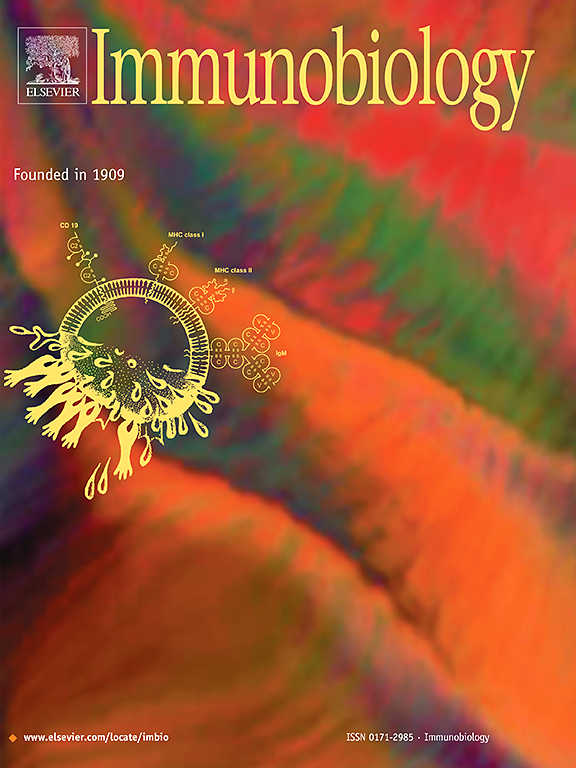AECOPD患者外周血相关炎症标志物的临床意义
IF 2.3
4区 医学
Q3 IMMUNOLOGY
引用次数: 0
摘要
近年来,包括全身免疫炎症指数(SII)、炎症反应指数(SIRI)、中性粒细胞与淋巴细胞比值(NLR)、血小板与淋巴细胞比值(PLR)和单核细胞与淋巴细胞比值(MLR)在内的外周血相关炎症标志物越来越受到临床的关注。本研究旨在探讨慢性阻塞性肺疾病急性加重期(AECOPD)患者外周血相关炎症标志物的临床意义。希望本研究能为AECOPD患者的临床个体化治疗和管理提供指导。方法选取2021年1月至2022年12月收治的254例AECOPD患者,分为轻度组和中重度组。采用单因素分析、Spearman相关分析和受试者工作特征曲线(ROC)研究外周血相关炎症标志物的临床价值。然后,通过生存分析和多因素Cox回归,进一步研究出院后一年内外周血相关炎症标志物与急性加重再入院风险的关系。结果中重度AECOPD患者外周血相关炎症标志物水平显著高于轻度组,且外周血相关炎症标志物水平与病情严重程度呈正相关。结合5项指标对中重度AECOPD的诊断准确率最高,截断值为0.38,AUC为0.837 (95% CI: 0.789-0.885)。外周血相关炎症标志物水平较高可能表明AECOPD和SII患者出院一年内再入院的风险较高(HR = 3.478, P <;0.001)是独立危险因素。此外,外周血相关炎症标志物水平升高也提示肺通气功能受损和右心室直径增大。结论外周血相关炎症指标(SII、SIRI、NLR、PLR、MLR)可作为鉴别中重度AECOPD患者的参考指标。外周血相关炎症标志物水平较高的患者在出院后一年内更容易出现急性加重和再入院事件。外周血相关炎症标志物可以帮助临床医生更科学、客观地评估AECOPD患者的病情,预测再入院风险。本文章由计算机程序翻译,如有差异,请以英文原文为准。
The Clinical significance of Peripheral Blood-related Inflammatory Markers in patients with AECOPD
Objective
Peripheral blood-related inflammatory markers, including systemic immune inflammation index (SII), inflammatory response index (SIRI), neutrophil-to-lymphocyte ratio (NLR), platelet-to-lymphocyte ratio (PLR), and monocyte-to-lymphocyte ratio (MLR), have received increasing clinical attention over the years. This study aims to investigate the clinical significance of peripheral blood-related inflammatory markers in patients with acute exacerbation of chronic obstructive pulmonary disease (AECOPD). We hope that this study will provide guidance for clinical individualized treatment and management of AECOPD patients.
Methods
A total of 254 patients with AECOPD admitted between January 2021 and December 2022 were enrolled in this study and categorized into mild and moderate-to-severe groups. Univariate analysis, Spearman correlation analysis, and receiver operating characteristic curve (ROC) were performed to study the clinical value of peripheral blood-related inflammatory markers. Then, the relationship between the peripheral blood-related inflammatory markers and the risk of readmission owing to acute exacerbation during the first year after discharge was further studied through survival analysis and multivariate Cox regression.
Results
The levels of peripheral blood-related inflammatory markers in patients with moderate-to-severe AECOPD were significantly higher than patients in the mild group, and the levels of peripheral blood-related inflammatory markers are positively correlated with the severity of disease. The highest diagnostic accuracy for moderate-to-severe AECOPD was achieved by combining five indexes, with a cut-off value of 0.38 and an AUC of 0.837 (95 % CI: 0.789–0.885). Higher levels of peripheral blood-related inflammatory markers may indicate a higher risk of readmission within one year of hospital discharge in patients with AECOPD, and SII (HR = 3.478, P < 0.001) was an independent risk factor. Besides, higher levels of peripheral blood-related inflammatory markers also suggest impaired pulmonary ventilation function and enlarged right ventricular diameter.
Conclusions
Peripheral blood-related inflammatory markers (SII, SIRI, NLR, PLR, MLR) can serve as a reference for identifying patients with moderate-to-severe AECOPD. Patients with higher levels of peripheral blood-related inflammatory markers are more susceptible to experiencing acute exacerbation and readmission events within one year after hospital discharge. Peripheral blood-related inflammatory markers can assist clinicians in evaluating the condition and predicting the risk of readmission in patients with AECOPD more scientifically and objectively.
求助全文
通过发布文献求助,成功后即可免费获取论文全文。
去求助
来源期刊

Immunobiology
医学-免疫学
CiteScore
5.00
自引率
3.60%
发文量
108
审稿时长
55 days
期刊介绍:
Immunobiology is a peer-reviewed journal that publishes highly innovative research approaches for a wide range of immunological subjects, including
• Innate Immunity,
• Adaptive Immunity,
• Complement Biology,
• Macrophage and Dendritic Cell Biology,
• Parasite Immunology,
• Tumour Immunology,
• Clinical Immunology,
• Immunogenetics,
• Immunotherapy and
• Immunopathology of infectious, allergic and autoimmune disease.
 求助内容:
求助内容: 应助结果提醒方式:
应助结果提醒方式:


